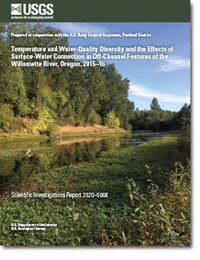Temperature and Water-Quality Diversity and the Effects of Surface-Water Connection in Off-Channel Features of the Willamette River, Oregon, 2015–16
Links
- Document: Report (11.6 MB pdf)
- Data Releases:
- USGS data release - Point measurements of temperature and water quality in main-channel and off-channel features of the Willamette River, 2015 -16
- USGS data release - Water surface elevations recorded by submerged water level loggers in off-channel features of the middle and upper Willamette River, Oregon, summer, 2016
- USGS data release - Continuous temperature measurements to assess upstream connection of off-channel features of the middle and upper Willamette River, Oregon, summer, 2016
- Download citation as: RIS | Dublin Core
Abstract
Water-quality conditions (including temperature) in the Willamette River and many of its adjacent off-channel features, such as alcoves and side channels, were monitored between river miles 67 (near Salem, Oregon) and 168 (near Eugene, Oregon) during the summers of 2015 and 2016. One or more parameters (water temperature, dissolved oxygen, pH, specific conductance, and [or] water depth) were continuously measured at sites in the main channel (9 sites in 2015; 5 sites in 2016) and select off-channel features (20 features in 2015; 22 features in 2016). This study was initiated in reaction to the unusually warm, dry weather and resulting low streamflows that occurred in the Pacific Northwest in 2015 and the need for flow managers to understand the effects of streamflow on water-quality conditions in off-channel features of the Willamette River. Field monitoring was focused on documenting water-quality conditions during low summer streamflows and during fluctuations in streamflow, including when side channels became alcoves and reconnected to become side channels again.
Water in the main channel of the Willamette River upstream from river mile 50 near Newberg typically is well mixed during summer, with warm water temperatures (greater than 18 degrees Celsius) and high dissolved-oxygen concentrations (often greater than 7.7 milligrams per liter). During low summer flows, a diverse suite of off-channel features exists adjacent to the main channel of the Willamette River. Despite temporal and spatial variability within individual features, comparison of continuous water-temperature data between the main channel and off-channel features indicated that some off-channel features were consistently cooler than the main channel, some were consistently warmer than the main channel, and others frequently fluctuated between warmer or cooler than the main channel. Site-specific characteristics including upstream connection, depth, and presence or absence of aquatic or riparian vegetation were factors that seemed to affect the water quality of a feature.
Results from this study showed a relation between the geomorphology, hydrology, ecology, and water quality of an off-channel feature. Data confirmed that many features that can be classified as cold-water refuges based on water-temperature standards also contained low concentrations of dissolved oxygen that may not be suitable for sensitive fish species. A simplified site classification scheme is proposed that links water-quality conditions in measured off-channel features with site-specific characteristics and summer streamflows. The site classification scheme was extended to create a theoretical process matrix that relates measured water-quality conditions to a list of the processes and site-specific characteristics that could create those conditions.
Suggested Citation
Smith, C.D., Mangano, J.F., and Rounds, S.A., 2020, Temperature and water-quality diversity and the effects of surface-water connection in off-channel features of the Willamette River, Oregon, 2015–16: U.S. Geological Survey Scientific Investigations Report 2020–5068, 70 p., https://doi.org/10.3133/sir20205068.
ISSN: 2328-0328 (online)
Study Area
Table of Contents
- Acknowledgments
- Executive Summary
- Introduction
- Methods
- Water-Quality Conditions of the Willamette River and Adjacent Off-Channel Features
- Effect of Upstream Morphology on Water Quality in Off-Channel Features
- Linking Site Characteristics and Water-Quality Processes in Off-Channel Features
- Conclusions and Implications for Research and Management
- References Cited
- Appendix 1. Comparison of Off-Channel to Main-Channel Water Temperatures for Continuously Monitored Sites
- Appendix 2. Aerial Imagery from 1994 and 2016 for Select Off-Channel Features
| Publication type | Report |
|---|---|
| Publication Subtype | USGS Numbered Series |
| Title | Temperature and water-quality diversity and the effects of surface-water connection in off-channel features of the Willamette River, Oregon, 2015–16 |
| Series title | Scientific Investigations Report |
| Series number | 2020-5068 |
| DOI | 10.3133/sir20205068 |
| Publication Date | September 16, 2020 |
| Year Published | 2020 |
| Language | English |
| Publisher | U.S. Geological Survey |
| Publisher location | Reston, VA |
| Contributing office(s) | Oregon Water Science Center |
| Description | Report: viii, 70 p.; 3 Data Releases |
| Country | United States |
| State | Oregon |
| Other Geospatial | Willamette River basin |
| Online Only (Y/N) | Y |


